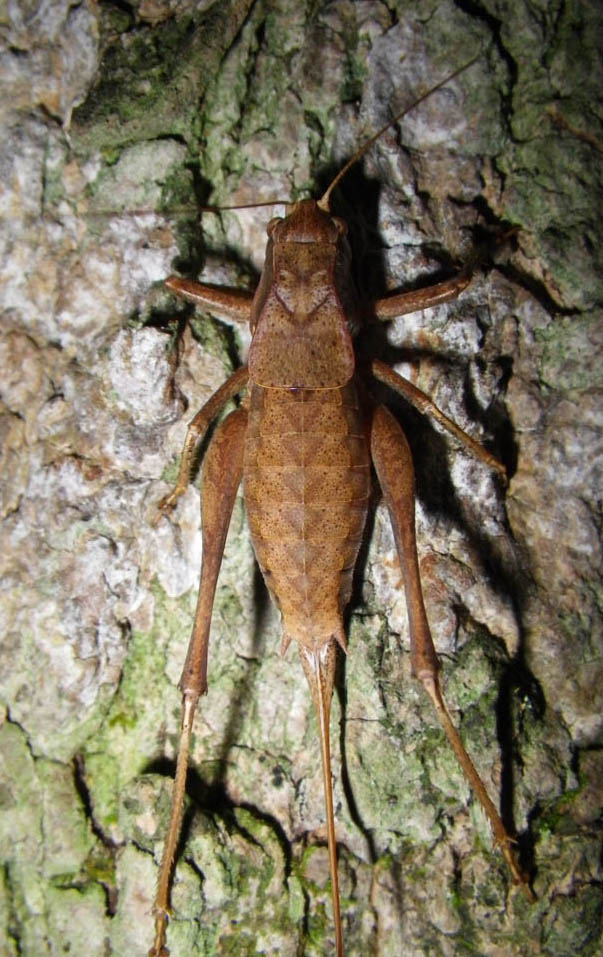The 2010 William H. Cross Expedition
Tims Ford State Park, Tennessee,14-18 June 2010
by Joe MacGown, 30 July 2010
Our 25th annual William H. Cross Expedition took place from 14 to 18 June, 2010 in south central Tennessee. During the week, we stayed and collected in Tims Ford State Park in Franklin County, but we also collected in several unique natural areas in the region including Short Springs State Natural Area in Coffee County, May Prairie State Natural Area in Coffee County, Grundy Forest Natural Area in Grundy County, and other sites. Most of the sites we visited were quite different, which allowed us to collect in a variety of habitats such as hardwood forests, mixed pine/hardwood forests, cedar forests, upland pine forests, hemlock forests, meadows, roadside fields, tall grass prairies, and other habitats.
The expedition leader for this year's trip was Stylianos (Stelios) Chatzimanolis, who studies staphylinid beetles at the University of Tennessee at Chattanooga, TN. Originally from Greece, Stelios is interested in evolutionary biology and documenting biodiversity. Other members of the expedition included Richard Brown (MEM director), Terry Schiefer (MEM curator), Joe MacGown (MEM Research Technician), JoVonn Hill (MEM Research Associate), Sangmi Lee (MEM Research Associate), James Lewis (MEM Research Associate), Jennifer Seltzer (MEM Research Associate), David Cross (MSU Research Associate), and David Plotkin (MEM masters student). Additionally, Thomas Simonsen and his wife Marie Djernaes joined us for two days mid-week. It was great to have David Cross along for this 25 anniversary of the first expedition, because the expedition was started in his father's name, William H. Cross.

Stelios collecting beside a creek
The expedition began on 14 June as we pulled into Tims Ford State Park at approximately 3 PM, where we met Stelios, who had arrived just before us. Both RIchard and David were unable to come on Monday with us, but planned on driving up on Tuesday, the 15th. We unloaded our gear into the two cabins that we rented for the week (cabins 15 and 16), which were located on a wooded slope overlooking the lake. After getting settled in a bit, James, Jennifer, and Sangmi went to find groceries, and the rest of us scouted the park, collected, and put out various traps. JoVonn and I put up a sheet with an mercury vapor lamp (MV) and a blacklight (BL) on the sloped hardwood forest behind cabin 15 ( 35°12’43”N 86°15’04”W). Stelios put out some baited pitfalls in the park, and Terry put out four Lindgren funnels in wooded areas in the park. While collecting, we noticed quite a few species of ants foraging (for a complete list of ants species, go to Ants collected during the 25th Annual Cross Expedition at Tims Ford State Park, Franklin County, Tennessee).
After the others returned from the store, we had supper, then put two sheets with UV lights out along the "Old Spann House Trail" in the park at 35°13’21”N 86°15’10”W. The trail wound through an open hardwood forest that was located near a creek. Collecting was not overly productive compared to some trips, but we did get some small beetles early on, and a variety of moths and other insects throughout the night. After the insect activity slowed down, we took the sheets down and went back to the cabins. Several of us collected at the sheet behind cabin 15 before calling it quits.
Tuesday Morning (15 June) Sangmi and Jennifer stayed at the cabin to spread moths. The rest of us, Terry, James, JoVonn, Stelios, David Cross, and I headed to the Short Springs State Natural Area (35°24’26”N 86°10’29”W) located about 3.5 miles northeast of Tullahoma, TN near Short Springs Road and Powell Road in Coffee County. The 420 acre natural area has a nice combination of rich forested slopes and ravines, springs and waterfalls, and open habitats with lots of wildflowers. The waterfalls were indeed wonderful, especially Machine Falls, which falls more than 60 feet. While we were there we collected numerous beetles, ants, and other insects from leaf litter, on flowers, beating vegetation, and by other means. An open field along a power-line right-of-way proved to be good collecting for several species of grasshoppers and cerambycids.
After leaving Short Springs, we headed over to the May Prairie State Natural Area and adjoining Hickory Flat Wood Wildlife Management Area located near Manchester, Coffee County. May Prairie itself is about 250 acres, and combined with the Hickory Flat Wood WMA, there is more than 1000 acres of public land. The most impressive aspect of the area is probably the open grassland community, which is one of the most diverse natural areas in Tennessee. We took a lat/long reading at the parking area at 35°27’25”N 86°01’32”W. We then collected along a trail in a hardwood forest that lead to an open, somewhat scrubby field and a tall grass prairie. While at the site, we concentrated our collections in different habitats to maximize our time. Terry and JoVonn concentrated on the prairie itself, while the rest of us spent more time in the mesic hardwood forest, and to a lesser degree, the open field habitat. An impending storm with high winds, lightning, and heavy rain, sent us scurrying to the truck, and we just missed being drenched. We headed back to the State Park through some heavy rain.
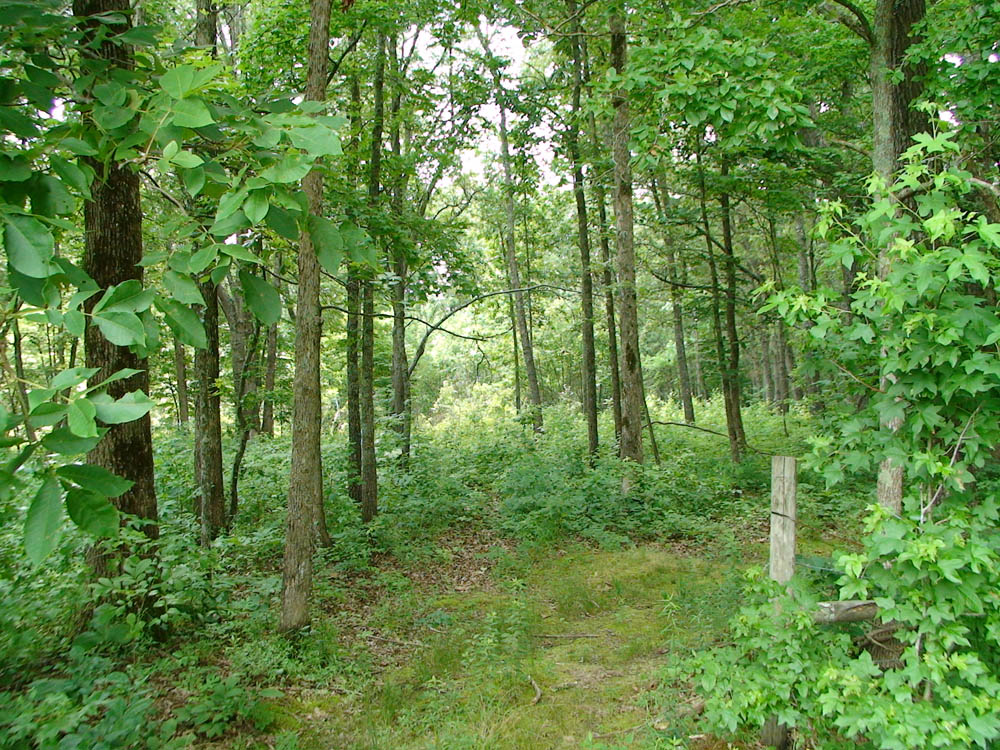
Oak-hickory forest at May Prairie N.A.
Upon our arrival at the State Park, we were greeted by Richard Brown and David Plotkin, who had arrived earlier. We spent our time taking care of the specimens we had collected, then we collected in the state park. Late in the afternoon Thomas Simonsen and his wife Marie drove up. After they settled in, we had supper, then most of us went back to Short Springs N. A. for a night of blacklighting. JoVonn, Jennifer, and James opted to stay at the cabin and collect at the sheet there. At the natural area, we put three sheets with lights out along the trail in the hardwood forest, and Terry put a boxtrap with blacklight out in the power-line cut. As in the previous night, collecting was less than wonderful, other than a few decent things here and there. We wrapped up our collecting relatively early, and went back to the cabin to collect and take care of our specimens.
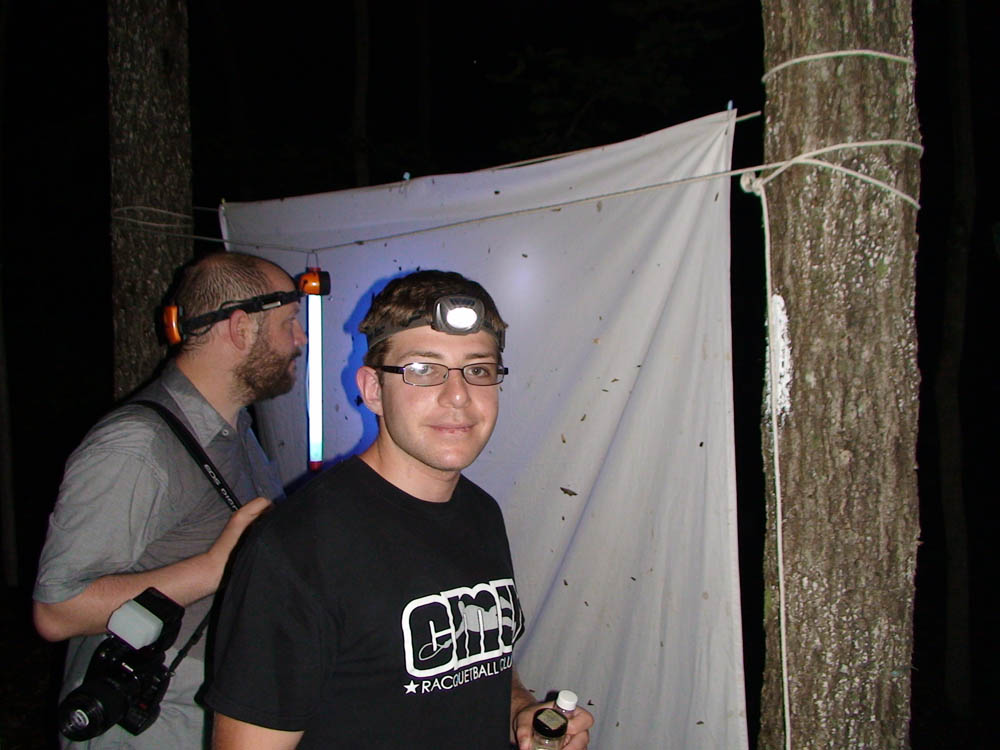
Thomas Simonsen and David Plotkin at a sheet
Early Wednesday morning (16 June), Richard, Sangmi, and David Plotkin retrieved the box trap from Short Springs. Richard's hopes of collecting large numbers of moths were dashed, because apparently the cyanide A-dust that we had used for a killing agent was no longer effective. However, there were a few interesting moths that were in good enough shape to keep. Nevertheless, all three of them and Jennifer, had plenty of moths to spread from the previous night. James and I both stayed at the state park to collect in various habitats there. Meanwhile, JoVonn, Stelios, Terry, and David Cross drove to South Cumberland State Park in Grundy County at 35°15'25"N 85°47'26"W, Hawkins Cove Natural Area in Franklin County at 35°10'27"N 85°57'56"W, and Sewanee Natural Bridge in Franklin County at 35°09'14"N 85°55'19"W. Although, they said collecting was pretty good at a meadow site at Cumberland State Park, they were mostly less than impressed with the area in general. Hawkins Cove, despite its only being 249 acres, was more interesting. The habitat at the site was an oak-hickory forest on a rocky, north facing slope, with small limestone cedar barrens interspersed. The Sewanee Natural Bridge only occupies about three acres, and is mainly a tourist attraction highlighted by a 25 feet high natural sandstone arch that spans about 50 feet.
That evening, Thomas and Marie left, and the rest of the group headed to Hawkins Cove to blacklight. Parking was tricky, because there was not a parking area. We basically had to pull onto a small grassy area located in a bend of the road. We scattered three sheets on the rocky hillside and collected until about 11 PM.
The next morning, Thursday 17 June, David Cross, Stelios, James, Terry, JoVonn, and I drove over to the Grundy Forest Natural Area in Grundy County. Grundy Forest is a beautiful 234 acre tract of land that features rocky streams, waterfalls, various rock formations, a hemlock cove forest, dry upland pine forest, and steep cliffs. We collected along the Fiery Gizzard Trail that lead through the different habitats. This small pocket of woods was reminiscent of the Smoky Mountains, and, in fact, several of the ants species that we collected there were also species that we find commonly in the Smokies.
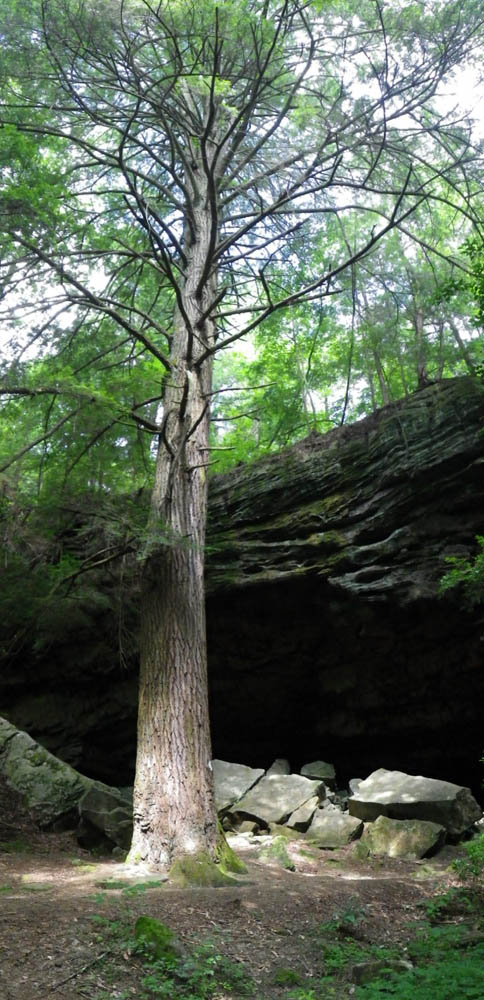
A huge hemlock in the Grundy Forest
After collecting at Grundy Forest until about lunch, we headed back to Tims Ford State Park (after stopping first at a Hardee's Restaurant). JoVonn and James spent much of the afternoon collecting in open areas in the state park. I collected some in a cedar/hardwood forest and in the hardwood forest near the Old Spann House Trail. I collected several bags of soil and leaf litter to take back to the lab for Berlese funnel extraction. While I was collecting at the trail site, I discovered a mixed colony of Formica subintegra and F. subsericea. The colony was underneath and in a rotting log on the ground. When I disturbed the colony, workers of both species aggressively attacked me. I collected a good series of both species and males of F. subintegra. Also present in the colony was a scarab larvae, probably a species of Euphoria, and Myrmicophilus pergandei, the eastern ant cricket.
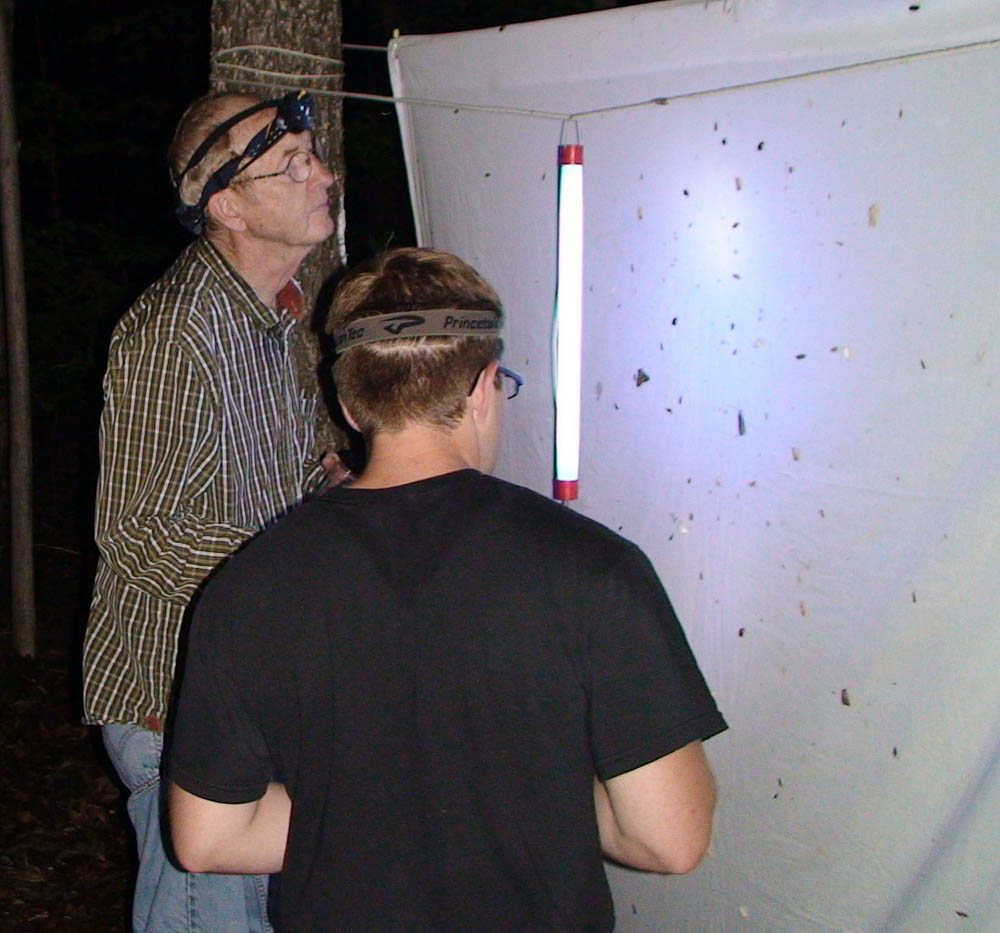
Richard Brown and David Plotkin collecting at sheet
That night, several of the crew went to the May Prairie site, where they set up sheets in the mesic hardwood forest. Additionally, Richard placed a box trap in the prairie itself. JoVonn, James, and I stayed at the cabin to collect. By all accounts, the collecting was again slow, and they took the sheets down relatively early.
The next morning, Friday the 18 of June, Richard picked up the box trap, and sorted through it that morning. JoVonn collected at the limestone cedar barrens at Hawkins Cove. Terry spent some of the morning taking down his Lindgren funnels. Stelios said his goodbyes that morning and headed back to Chattanooga. David Cross, James, and I also headed back to Starkville that morning. Everybody else left sometime later after lunch.
Collecting Sites
Tims Ford State Park, Franklin Co., TENN.
Cabin Area (blacklight/MV lamp, general collecting, Lindgren funnels14-17 June 2010)
TENN., Franklin Co.
Tims Ford St. Park
35°12’43”N 86°15’04”W
hardwood forest
mixed pine/hardwood forest
cedar/hardwood forest
roadside field
Old Spann House Trail, near entrance of campground (blacklight 14 June 2010, general collecting 14-17 June)
TENN., Franklin Co.
Tims Ford St. Park
35°13’21”N 86°15’10”W
hardwood forest
near creek
Coffee County Sites
Short Springs Rd. X Powell Rd., (blacklght in woods, boxtrap at powerline, day collecting on 15 June 2010)
TENN., Coffee Co.
Short Springs St. N.A.
35°24’26”N 86°10’29”W
hardwood forest
2nd growth forest
powerline cut
May Prairie State Natural Area/Hickory Flat Wood Wildlife Management Area (general collecting 15 June 2010, blacklight in woods, boxtrap in prairie on 17 June 2010)
TENN., Coffee Co.
May Prairie St. N.A.
35°27’25”N 86°01’32”W
hardwood forest
prairie
field
Franklin Country Sites
Hawkins Cove Natural Area (blacklight on 16 June 2010, general collecting 16 and 18 June 2010)
TENN., Franklin Co.
Hawkins Cove N.A.
35°10'27"N 85°57'56"W
hardwood forest on rocky slope
Sewanee Natural Bridge (general collecting 16 June 2010)
TENN.,Franklin Co.
Sewanee Natural Bridge
35°09'14"N 85°55'19"W
Grundy County Sites
Cumberland State Park 16 June 2010
TENN.,Grundy Co.
South Cumberland S.P.
35°15'25"N 85°47'26"W
Meadow Trail
Grundy Forest Natural Area, Fiery Gizzard Trail (general collecting 17 June 2010)
TENN., Grundy Co.
Grundy Forest N.A.
35°15’12”N 85°45’45”W
hemlock/hardwood forest


